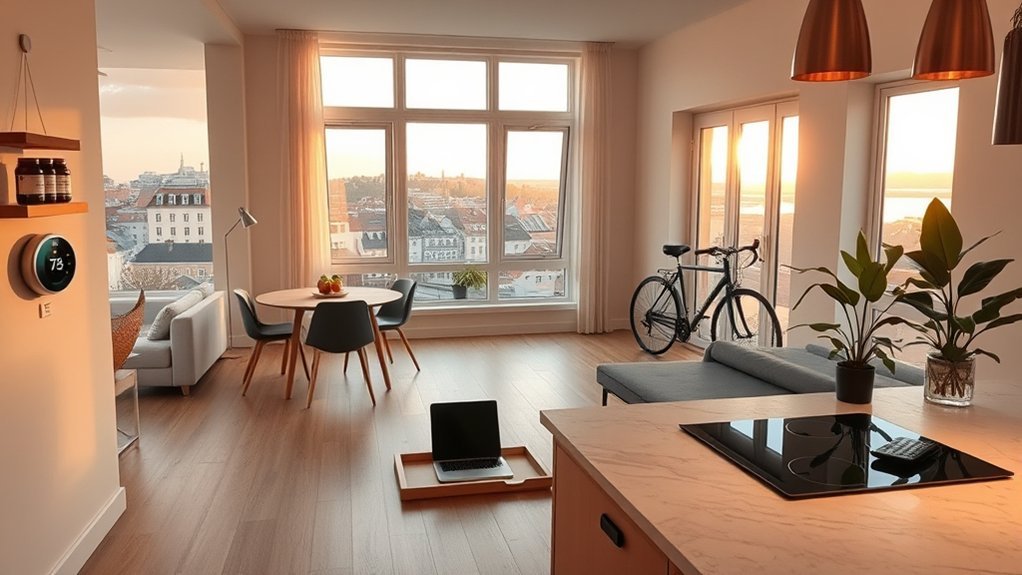Stockholm’s pricey: expect 15,000–16,500 SEK/month for a central 1‑bed (about 9,800–10,000 SEK outside). Non‑rent living costs for one average ~2,448 SEK, groceries ~1,600–2,000 SEK, and an SL 30‑day pass ~1,020–1,070 SEK. A mid‑range meal for two runs ~1,000 SEK; a pint ~70–110 SEK. Utilities for an 85–90 m² flat are ~1,870–2,213 SEK. Singles typically budget ~19,000–21,000 SEK in the center, ~12,900–14,000 SEK outside. Here’s how those numbers break down further.
Is Stockholm Expensive?

Although Sweden is generally pricey, Stockholm stands out as the country’s most expensive city and ranks 26th in Europe. You’ll feel it in monthly expenses: Numbeo estimates about 2,448 SEK for a single person and 6,117 SEK for a family of four, excluding rent. Relative to neighbors, Stockholm’s cost of living is roughly 1,427 SEK/month cheaper than London for a single person but about 171 SEK higher than Berlin.
Restaurants and groceries push costs up: expect around 1,000 SEK for a mid-range meal for two, 110 SEK for a domestic draft beer, 79.5 SEK for a cappuccino, and 29 SEK for a loaf of bread. Public transport is efficient but adds to recurring outlays. While rent deserves its own section, it’s a major driver—especially for an apartment in the city—helping explain why Stockholm posts Sweden’s highest COL and rent indices, and why smaller cities remain materially cheaper alternatives.
Rent Per Month
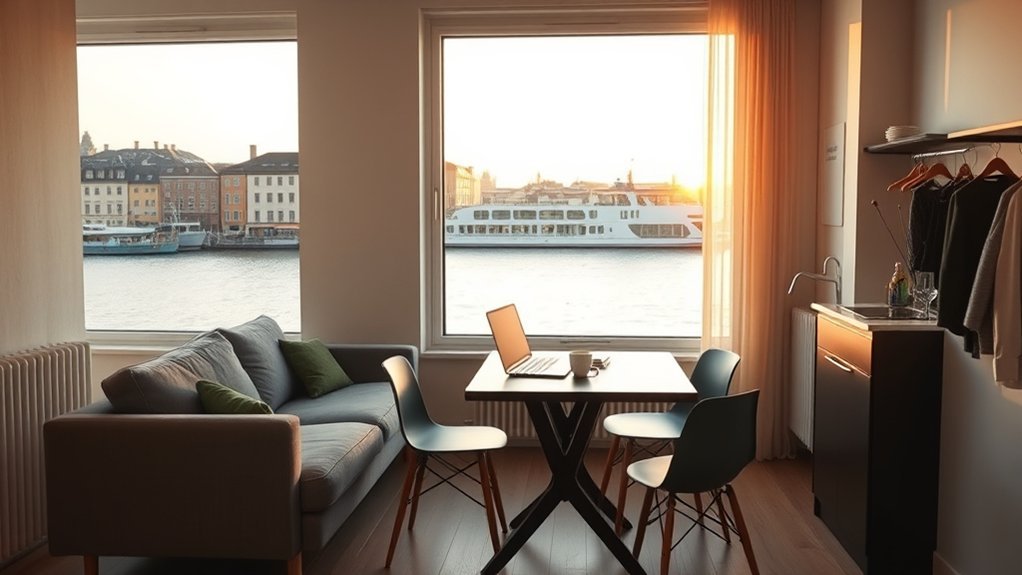
For a city-center one-bedroom, you’ll typically budget around 15,025 kr per month, with listings ranging from 9,000 to 20,000 kr.
If you need a three-bedroom family option in the center, expect an average near 26,143 kr, but the range is wide at 18,000–50,000 kr.
Given the housing shortage, you should plan for scarce availability and competition.
City-Center One-Bed
Expect to shell out about 15,000–16,500 SEK per month for a one‑bed in Stockholm’s city centre, with observed listings spanning roughly 9,000–25,000 SEK and a common 13,000–18,000 SEK band.
In Stockholm, a city centre 1-bedroom rent typically lands near a 15,025 SEK per month monthly cost, closely aligned with aggregated sources around 16,398 SEK per month.
You’ll face intense rent competition due to a persistent housing shortage, which pushes SEK per month asking levels up and sustains frequent sublets.
Many available units are compact “mini flats,” keeping nominal prices within the 13,000–18,000 SEK zone while elevating effective apartment prices per square foot.
High downtown purchase values—about 10,370 SEK per sq ft—reinforce why central rents sit well above outer districts.
Three-Bed Family Option
Moving from a central one-bed to a three-bed, you’re looking at roughly 26,000 kr per month in Stockholm’s city centre, with listings spanning about 18,000–50,000 kr depending on area and condition.
Reported three-bedroom rent averages vary: 26,143 kr is common, while some sources cite about 27,762 kr, reflecting premium neighbourhoods like Östermalm versus more affordable Solna/Sundbyberg.
Outside city centre, a consistent local estimate is around 16,250 kr per month.
You’ll likely pay utilities (monthly) on top of rent.
For an 85–95 m² place, expect about 1,871–2,213 kr, pushing monthly living costs above the headline price.
Due to Sweden’s housing shortage and long queues, you may face scarce listings, subletting, and elevated secondary-market prices—especially for family-sized homes in Stockholm.
How to Find an Apartment in Stockholm
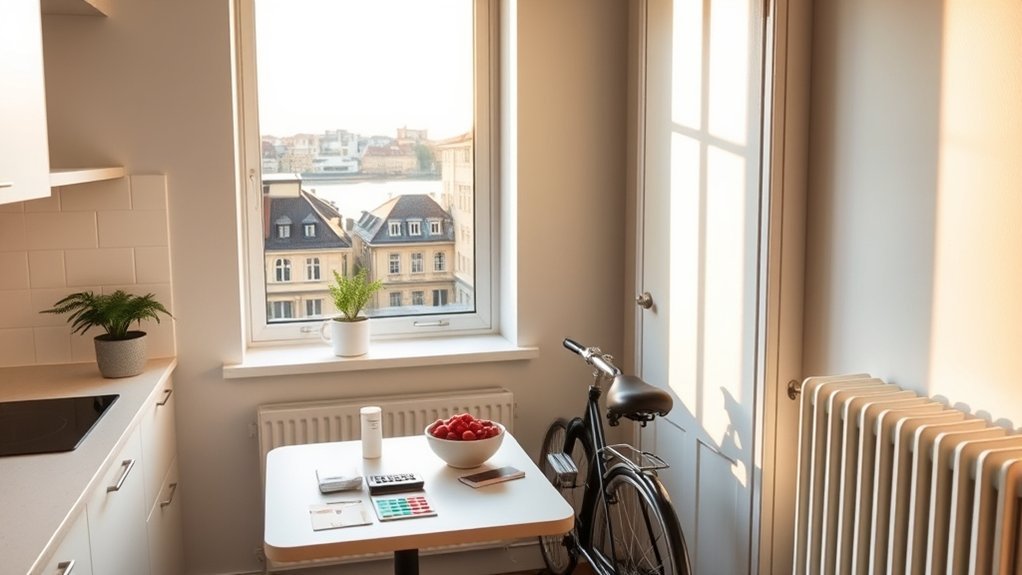
Start by registering early with municipal bostadskö and major private queues, as first‑hand contract waits are measured in years.
For immediate options, use Blocket.se, Facebook groups, and short‑term platforms like Samtrygg, Allihoop, or Colive, and expect central 1‑bedroom listings around 10,000–25,000 SEK/month.
To avoid scams, never pay before viewing and verifying the landlord, confirm consent for second‑hand rentals, and get a written contract with clear terms on utilities. Regular inspections are essential to maintaining proper air conditioning function in your living space, ensuring comfort in the warmer months.
Rental Platforms and Queues
Cut through Stockholm’s tight rental market by combining formal queues with private platforms. Start with the municipal bostadskö; long waits make it the main path to stable, affordable leases. Parallel this with Blocket.se and Facebook groups to track real‑time supply. Prepare proof of employment, residency permit, and ID to move fast—competition is intense. Benchmark Stockholm rent using city centre rents: expect 15,000–18,000 SEK/month for a 1‑bed (range 9,000–25,000+).
| Path | Use case |
|---|---|
| Municipal bostadskö | First‑hand contracts; long horizon |
| Blocket.se, Facebook | Broad listings; verify terms |
| Samtrygg, co‑living providers | Short‑term sublet, utilities bundled |
If you lack a Swedish ID, consider Samtrygg (adds 30‑day insurance) or co‑living providers like Allihoop and Colive. For second‑hand rentals, confirm landlord consent and compare prices frequently to avoid inflated offers.
Avoiding Rental Scams
While you cast a wide net across bostadskö, Blocket, and Facebook groups, protect yourself against scams with strict verification. Treat rental scams as a probability problem: higher urgency and upfront payments increase risk.
On Blocket.se, never transfer money before you’ve seen the apartment, confirmed the landlord’s ID, and matched names to the property deed. Use Samtrygg for safer sublets and escrow; it supports tenants without a Swedish personal identity number.
Prioritize lease legitimacy: request the full contract, landlord consent for subletting, and written receipts for deposits. Apply deposit verification by paying only through traceable methods; avoid wire requests and intermediaries.
For short-term housing, compare Allihoop, Colive, and BostadDirekt—utilities often included, faster onboarding. Join the municipal bostadskö early; first-hand contracts require long waits.
Property Prices and Mortgages
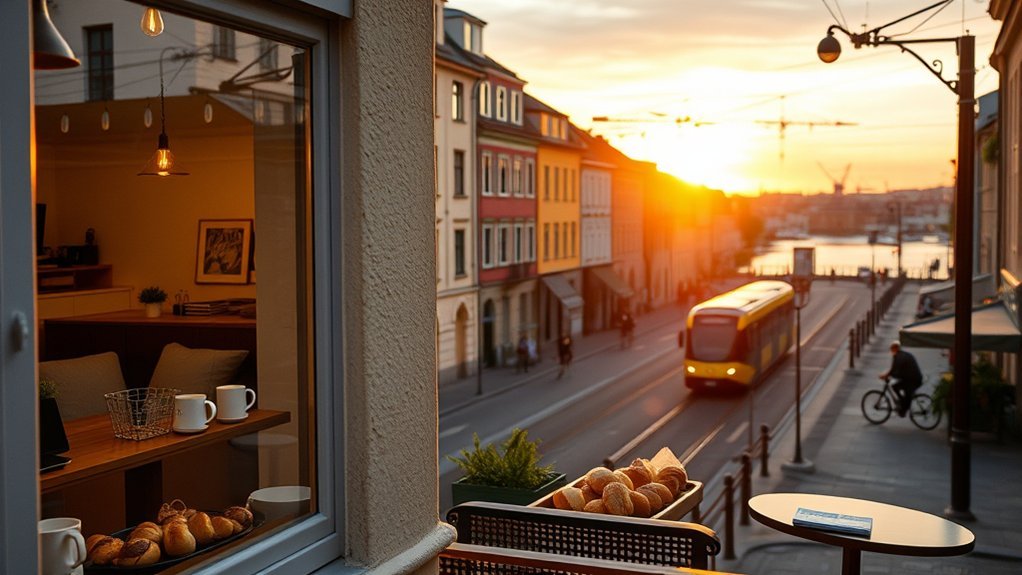
Even with Stockholm’s housing shortage, you can benchmark purchases at roughly 10,370 kr per sq ft in the city centre (about 9,290–11,807 kr) and 5,727 kr outside (about 4,506–7,897 kr), while one‑bedroom city‑centre rents hover around 15,000–16,400 kr per month.
In the Stockholm city centre, that price per sq ft implies a high entry ticket, so plan for a 15% down payment, plus a 4.25% stamp duty on the purchase price. Banks typically finance up to 85% for resident and qualified foreign buyers.
You’ll see mortgage interest rate offers near 4% today, with forecasts pointing toward ~2.5% if cuts materialize.
On resale, budget for a 30% capital‑gains tax.
Market signals remain tight: supply constraints and the housing shortage support a 5–10% price rise by 2025. Additionally, local market conditions in Stockholm can significantly influence overall housing costs.
If rent vs buy is close, compare one‑bedroom rent against total ownership cost (interest, amortization, taxes, fees) to gauge breakeven and risk under rate or price shifts.
Utilities and Internet
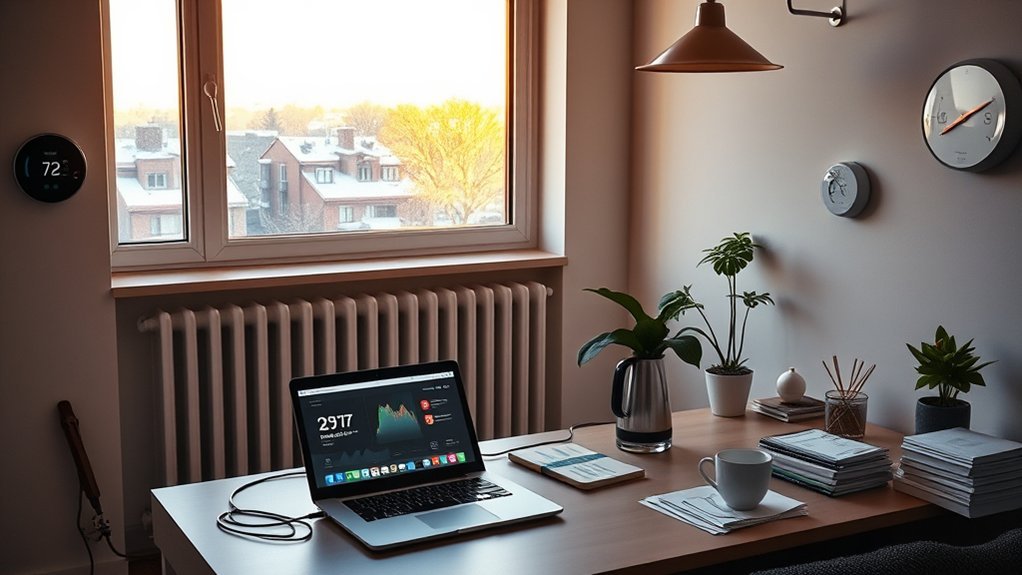
After sizing up housing costs, factor in monthly running expenses. For an ~85–915 sq ft apartment, basic utilities—electricity, heating, cooling, water, garbage—average 1,870–2,213 kr/month, with a wider range of roughly 850–4,474 kr depending on usage and building efficiency. Add home internet (60 Mbps+ unlimited) at about 303–412 kr/month (typical range 205–500 kr). Expect combined monthly costs for utilities + internet to land near 2,200–2,600 kr in a small apartment, varying by consumption and internet providers. It’s important to note that schools often face budget constraints which can also impact repair decisions for computers.
| Item | Typical Monthly Cost |
|---|---|
| Utilities (avg) | 1,870–2,213 kr |
| Home internet | 303–412 kr |
| Utilities + internet (small apt) | 2,200–2,600 kr |
| Phone plans (10GB) | 23–30 kr |
To keep monthly costs down, compare providers like Telia, Telenor, Tele2, Comviq, and Hallon. Consider bundling utilities and home internet where available, or switch internet providers via open-fiber networks. Use PriceRunner or Compricer to benchmark offers; monitor seasonal heating to manage spikes.
Public Transport and Commuting

For daily travel in Stockholm, SL’s integrated network makes budgeting straightforward: a single 75‑minute ticket costs about 42–43 kr and works across metro, buses, and local trains, but frequent riders cut costs with passes. You’ll load an SL card or use the app to buy and validate a one-way ticket, short-term options, or a monthly pass.
If you commute often, plan on a 30‑day pass at roughly 1,020–1,070 kr; it typically lowers commuting costs versus buying single rides. Short stays fit 24‑hour, 72‑hour, or 7‑day products, while children under 7 travel free. Concessions apply for riders under 20, over 65, and eligible students, further reducing public transport spend.
The metro is fastest in central Stockholm; buses and ferries connect outer districts. To minimize annual commuting costs, consider an annual pass. SL’s app streamlines payments and renewals. Choose the product that matches your travel frequency to keep transport spending predictable.
Food and Groceries

Start with a clear budget: cooking at home in Stockholm typically runs 1,600–2,000 SEK per month for one person, while a family of four spends around 8,000–10,000 SEK. That anchors your monthly food spending within the broader cost of living.
Expect these grocery prices: milk around 58–63 SEK per gallon, a 1 lb loaf of white bread 26–29 SEK, a dozen eggs ~45 SEK, chicken fillets (~1 lb) ~58 SEK, and beef round (~1 lb) ~85 SEK.
To keep food and groceries affordable, use budget grocery chains like Lidl and Willys, buy frozen fruits and vegetables, and shop larger stores (ICA Maxi) for better unit prices.
Eating out pushes costs up: an inexpensive meal is 120–150 SEK, a mid-range dinner for two 700–1,000 SEK, and a domestic pint 70–110 SEK. If you eat out regularly, your monthly food costs can rise toward 6,000–10,000 SEK.
Plan meals, track deals, and use discount apps to control spend. Additionally, consider implementing regular maintenance of your food budget to avoid unexpected spikes in your grocery expenses.
Childcare and Education

Groceries set a baseline, but families feel the budget swing most in childcare and schooling.
In Stockholm, public preschool (förskola) for ages 1–5 uses income‑based municipal fees capped by the national maxtaxa. Expect full‑day costs around 1,300–1,800 SEK per month per child, with a typical figure near 1,527.60 SEK for private preschool operating under the same cap. Access to subsidised daycare usually requires a personnummer and municipal registration; until you’re registered, you may need private or interim care.
Parental leave covers 480 days per child (about 420 paid at up to ~80% of salary). While on leave, your child is entitled to at least 15 hours of preschool weekly, which can reduce costs early on.
Schooling diverges for expats: international school tuition is substantially higher, commonly around 130,000–150,000 SEK per year (e.g., ~146,000 SEK). Fees vary widely by school and tier, with listed examples ranging roughly from 6,658 SEK to 155,000 SEK annually. Additionally, families can benefit from long-term savings when they utilize public options, helping to alleviate overall education costs.
Average Monthly Budget Examples
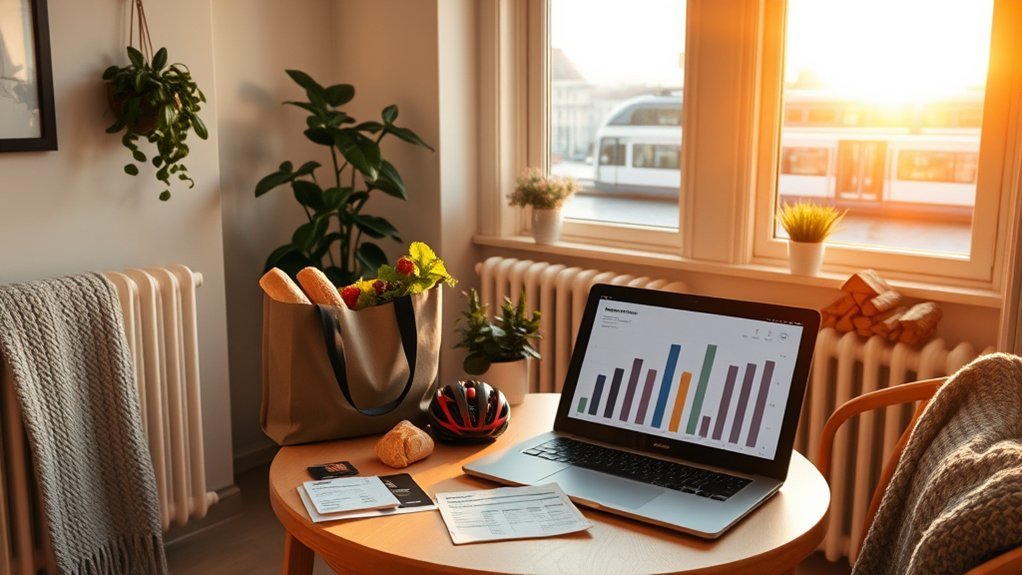
Build a realistic snapshot by pairing Numbeo’s non‑rent baselines with typical rents and essentials. In Stockholm, a single person’s monthly cost of living (excluding rent) is about 2,448 SEK; a family of four’s is ~6,117 SEK. Layer in rent, utilities, groceries, and public transport to see your total.
Pair Numbeo’s non‑rent baselines with rent and essentials to estimate Stockholm monthly costs.
1) Single person, city centre 1‑bed:
- Rent: 15,000–16,400 SEK; baseline: 2,448 SEK.
- Add pass: 1,020–1,060 SEK; groceries: 1,600–2,000 SEK.
- Total aligns with ~16,398 SEK using Numbeo’s inclusion; with detailed adds, expect ~19,000–21,000 SEK.
2) Single person, outside centre 1‑bed:
- Rent: 9,800–10,000 SEK; baseline: 2,448 SEK.
- Transport: ~1,020–1,060 SEK; groceries: 1,600–2,000 SEK.
- Expect ~12,900–14,000 SEK; Numbeo suggests ~10,880–11,448 SEK.
3) Family of four, 2–3‑room outside centre:
- Utilities (85–90 m²): 1,870–2,213 SEK; groceries: 8,000–10,000 SEK.
- Add public transport (2 adults): ~2,040 SEK.
- With rent variability, plan broadly: ~25,000–35,000+ SEK.
Additionally, consider the long-term savings associated with investing in a home gym, which can significantly reduce ongoing expenses related to gym memberships.
Frequently Asked Questions
How Much Is Rent in Stockholm per Month?
You’ll typically pay 15,000–16,400 kr for a central 1‑bed, ~9,800–10,000 kr outside. Check utilities included, pet deposits, student housing, housing cooperatives, sublet options, short term leases, studio upgrades, and neighborhood trends; verify listings to avoid scams.
Is It Cheaper to Live in the USA or Sweden?
It depends: you weigh two scales. Sweden often wins on food prices, transportation costs, healthcare access, education expenses, and quality adjustments; the U.S. can win on taxes and some housing policies. Do a city-specific cost comparison, including tax implications.
How Much to Live Comfortably in Stockholm?
Plan on 18,000–20,000 SEK/month solo, 35,000+ for a family. Optimize neighborhood selection, transport options, utility costs, internet plans, food budgeting, and leisure spending. Factor healthcare access, seasonal clothing, and rent variability by location to maintain comfort.
How Much Is Rent in Sweden in US Dollars?
You’ll pay roughly $850–$2,400 monthly, depending on city and size. Average rents vary across uneven regions. Check student housing, short term rentals, furnished options, utilities included, pet policies, and lease durations. Stockholm skews highest; smaller towns cost less.
Conclusion
You’ve crunched the numbers and, surprise, Stockholm isn’t expensive—unless you enjoy housing, eating, moving, or existing. You’ll pay premium rent to live small, top-tier utilities to stay warm, and gourmet prices for bread that’s mostly air. Transit’s efficient enough to remind you you’re late by choice. Childcare and school? Great value—once you win the waiting-list lottery. Still, with smart budgeting, public transport, and secondhand treasures, you’ll thrive. Or at least, you’ll collect immaculate receipts.

